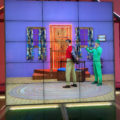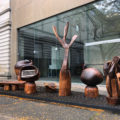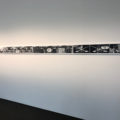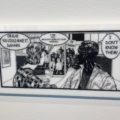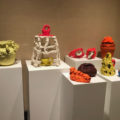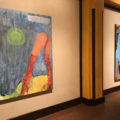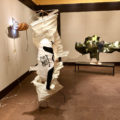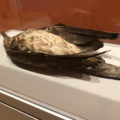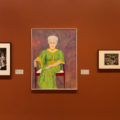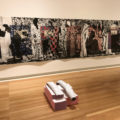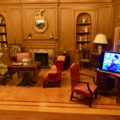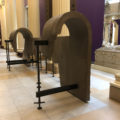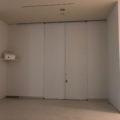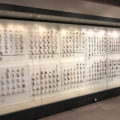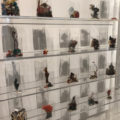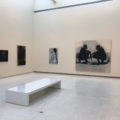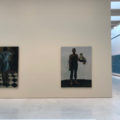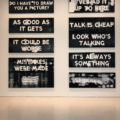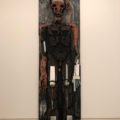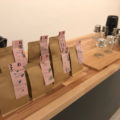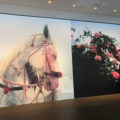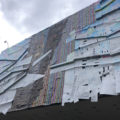[ad_1]
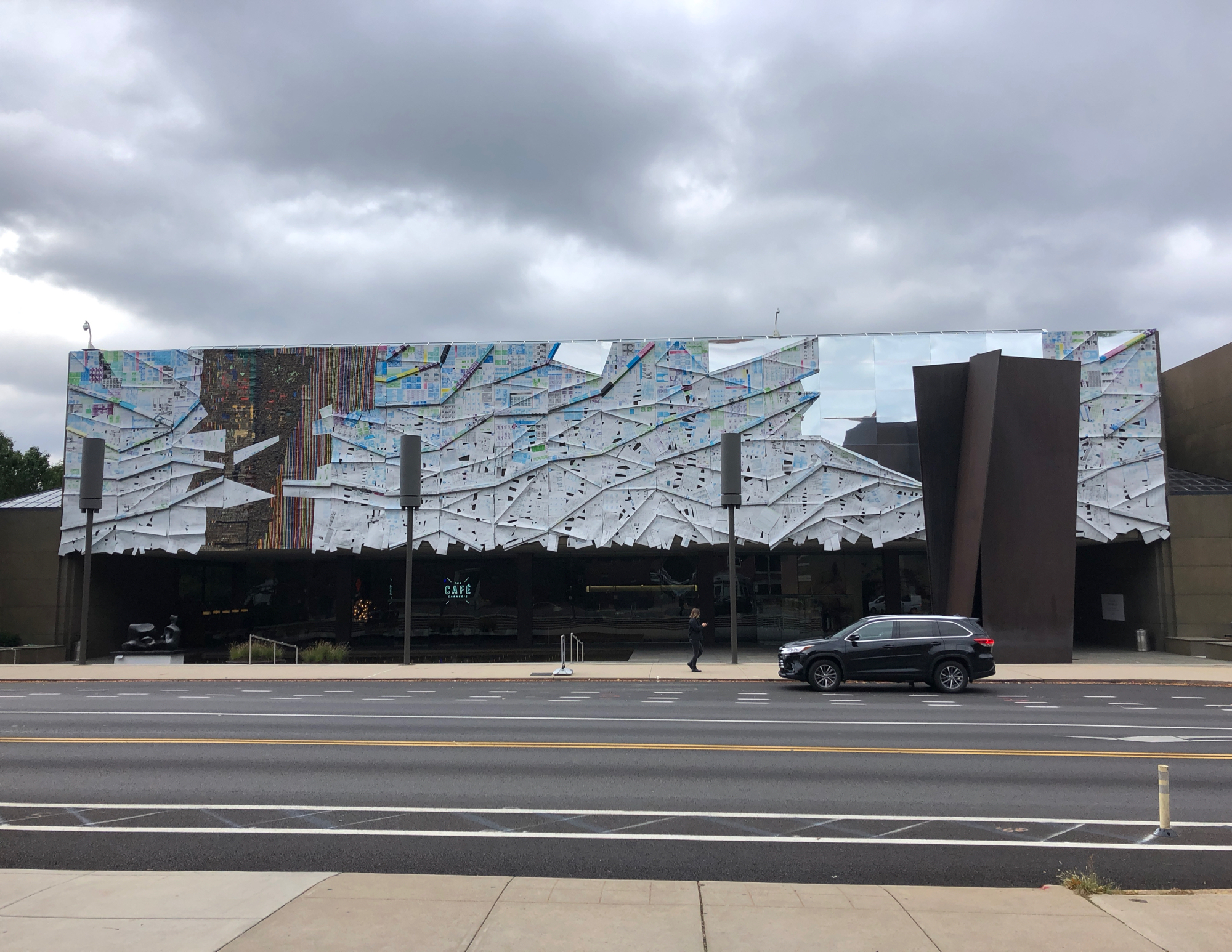
A standout of the 2018 Carnegie International, El Anatsui’s Three Angles ornaments one facade of the Carnegie Museum of Art in Pittsburgh, its mirrors pulling the sky into the building. Richard Serra’s Carnegie (1985) stand sentinel at right.
ALL PHOTOS: ANDREW RUSSETH/ARTNEWS
Sitting down to review the 57th Carnegie International, which opened at the Carnegie Museum of Art in Pittsburgh this past weekend, I am in the peculiar—and painful—position of wanting to write both a rave and a pan. I am deeply divided, and I am going to try to explain.
The show is, in many ways, exemplary. Its organizer, Ingrid Schaffner, has selected only 33 participants—many of them leading lights of their generations, more than half of them women—and given them plenty of space, so that one almost has the sense of visiting a series of impressive one- and two-person shows. Schaffner’s admirably restrained in her conceptual underpinning, as well. Her aim, she writes in a handsome little catalogue called The Guide, “is to inspire museum joy,” which “comes from the commotion of being with art and other people actively engaged in the creative work of interpretation.”
Her International is a positively joyous affair. The great Ghanaian-born artist El Anatsui has draped one of his glorious tapestries—a rippling quilt of bottle caps, metal printing plates, and mirrors—across the long stone facade of the museum’s Edward Larrabee Barnes–designed building, where I propose it remain for the rest of time. New Yorker Jessi Reaves has a whole room for her furniture sculptures, which resemble the exuberant offspring of John Chamberlain and Lee Bontecou and just getting funkier and funnier. Hometown hero Thaddeus Mosley, still going strong at 92, has placed a menagerie of his rollicking wood-carved sculptures in the museum and its courtyard. And the Londoner Lynette Yiadom-Boakye has hung 13 of her inimitable paintings—tender portraits of imaginary young black men and women that she conjures against brushy fields of pure color. These figures seem to float into the room.

All sweetness and light: at left, fabric works by Ulrike Müller; at right, a wall by Sarah Crowner.
Unlike so many grand contemporary art exhibitions (last year’s Documenta 14 in Athens and Kassel, Germany, for example), this edition of the every-five-years International has no aversion to seductive visual moments, and it approaches politics with welcome humility. It is a thrill to know that huge numbers of people who may not regularly visit commercial galleries will have this considered, succinctly edited show, which runs through March 25, 2019, as their status update on contemporary art.
[View photos of the exhibition.]
And yet, even while reveling in the exhibition’s many fine works, I felt a sense of disappointment, of lingering emptiness. I kept waiting to see artists take ambitious risks, and with very few exceptions, I was left wanting. Much of the work is anodyne and backward-looking—conservative, in a word. Not even a Jeff Sessions would find much to be offended by here.
Karen Kilimnik’s installed a bunch of her attractive little paintings of flowers, mansions, and landscapes in the decorative-arts wing of the museum, and on opening day, she presented a campy dance piece, its choreography assembled from bits of preexisting ballets. Art Labor, a group based in Ho Chi Minh City, Vietnam, is offering tasty coffee from their homeland a couple hours a day. And in the type of ponderous live piece that’s de rigueur for these shows, Pittsburgh’s Lenka Clayton and Jon Rubin have tapped professional calligraphers to paint the titles of the more than 10,000 works rejected from the International (it was an annual open-call through 1931) onto sheets of paper, which visitors can take home. It’s all very twee.
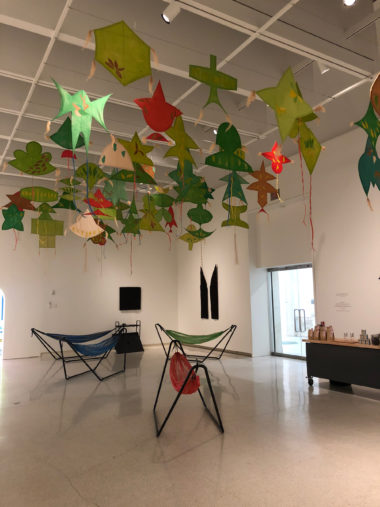
On the ceiling, kites made by the father of a member of the Vietnamese collective Art Labor, which Joan Jonas has painted. Below, works by Art Labor, including hammocks and a coffee stand offering sweet Vietnamese coffee.
Twee, of course, is lovely in certain doses, but many displays also fetishize canonized history, which grates. Working with the Chicago art dealers John Corbett and Jim Dempsey, the New York–based Josiah McElheny has placed some of his glass sculptures in a show within the show that sports a smattering of record covers, photos, and other ephemera related to avant-gardists like John Cage and Sun Ra, plus a few more obscure figures, like Betty Rockwell Raphael, who ran a free-thinking gallery in Pittsburgh in the 1940s. Similarly, London’s Otolith Group presents a lackluster short film that fixates on the jazz trio Codona recording its first album in the late ’70s and the writer Gertrude Stein. It rankles that such valuable real estate and screen time was not given instead to venturesome composers and musicians working today.
While one cannot say that the show is out of touch the present moment’s tumult and trauma, such matters are broached only subtly, guardedly, and not always with success. In the museum’s Hall of Architecture, amid plaster casts of heroically scaled Western buildings, the Kuwaiti-born artist Saba Innab shows a fragment of a tunnel modeled on one found in Gaza, though visitors will only learn that fact if they read The Guide. There is no explanatory wall text anywhere in the show, which feels at once generous—“Trust your eyes, enjoy,” it seems to say—and dangerously close to an elitist strain of anti-intellectualism. In any sense, without that piquant detail, Innab’s work looks merely like a tired bit of unmonumentalism.
Central to Schaffner’s International are questions about how histories and bodies of knowledge are constructed, preserved, and transmitted. The Cameroonian exhibition maker Koyo Kouoh has dug through the Carnegie’s collection and marshaled a Wunderkammer of art and artifacts focused on labor, colonialism, and depictions of power. That’s a well-worn intervention, but it’s at least surprising in execution—a Cecil Beaton photo of Queen Elizabeth II hangs next to Beauford Delaney’s portrait of a white-maned Pittsburgh philanthropist, and one vitrine contains (you cannot make this up) a bald eagle shot down during the Battle of Gettysburg.
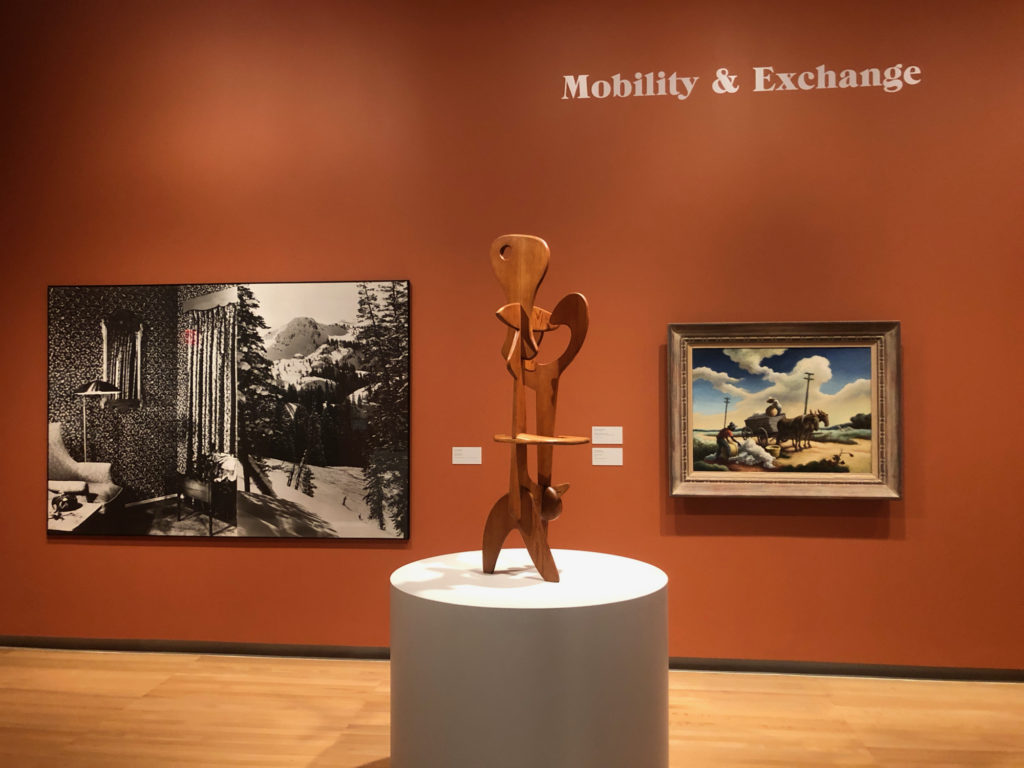
An installation view of “Dig Where You Stand,” an exhibition within the International by Koyo Kouoh. Here are pieces by three Americans: John Baldessari, Isamu Noguchi, and Thomas Hart Benton.
Also investigating the ways the past gets remembered is the Korean filmmaker IM Heung-soon, who has put together a two-screen video work juxtaposing interviews with victims and witnesses of the political violence in Argentina in the late 1970s and South Korea in 1980. It’s effective, but it’s only one part of a cumbersome three-room display that includes a video by the novelist Han Kang, another that’s a collaboration between the two, and other pieces. The result is a jumble, with the soundtracks bleeding into each other. In a show that is otherwise a masterclass in exhibition design and pacing, it’s the lone misfire.
Much better is the one-two punch in the museum’s Hall of Sculpture, where modest black-and-white snapshots of water by New Yorker Zoe Leonard line the walls of the Beaux-Arts space’s upper level. The Plan, a charming little map for the show, offers this as an explanation: “Rio Grande rings the balcony.” We’re seeing the U.S.-Mexico borderline—the target of so much bad-faith sloganeering—intimately, as just close-up shots of streams flowing over rocks, and it’s as uncanny and mournful as the desolate Paris streets in Eugène Atget’s photographs.
Down below, meanwhile, the collective Postcommodity has covered the floor with angular patches of the stuff of faded Pittsburgh industry: crushed glass, coal, and rusting steel. The collective’s members, who come from First Nations in North America, imagined the piece as a graphic score for musicians, and on Saturday it was brought to life with ebullient energy by the performer Aaron Johnson, switching between trombone and various conches. Seeing it was nothing less than total museum joy.
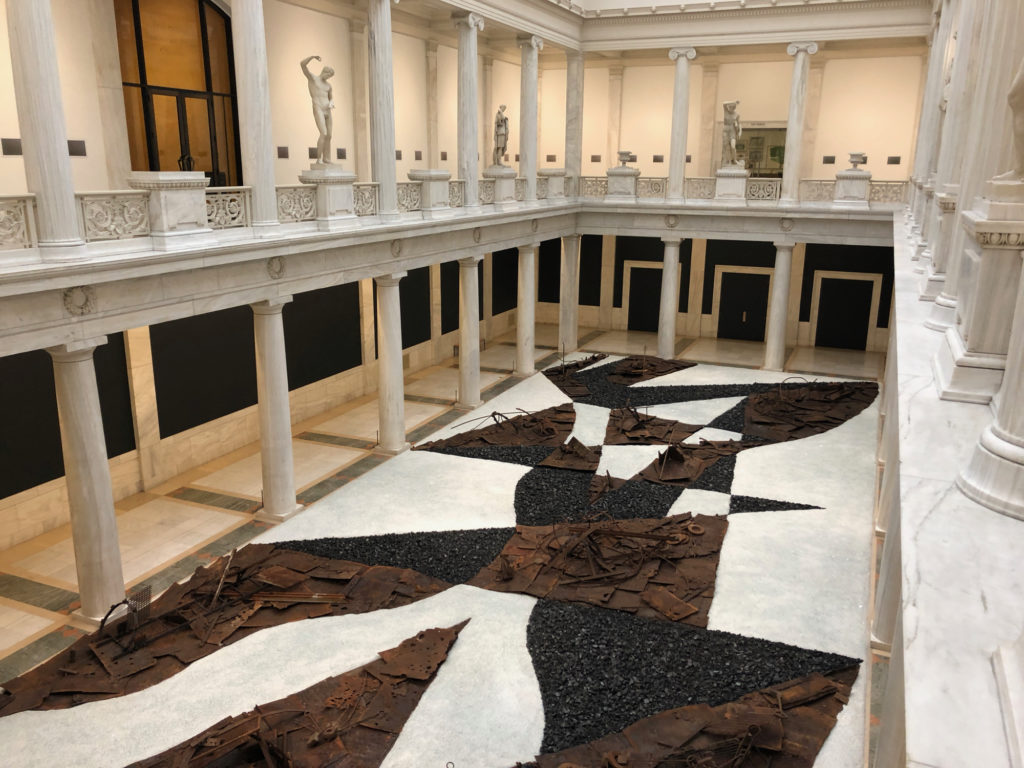
The Hall of Sculpture at the Carnegie Museum of Art, with Postcommodity’s From Smoke and Tangled Waters We Carried Fire Home (2018) on the floor and a ring on the upper level of photographs by Zoe Leonard of the Rio Grande.
That moment of improvisation feels central to the 2018 International, whose key subject may be the act of making art itself—how it is done, and why. Often, the show suggests, it is the result of the unglamorous, workaday efforts of obsessives. Every day for a year, New York treasure hunter Yuji Agematsu filled a different cigarette plastic wrapper with tiny bits of trash he found while wandering his city, and all 365 sit on shelves in the show, arrayed like a calendar. Here, too, are meticulous, luscious botanical drawings that Abel Rodríguez makes, filling them with information he learned growing up as a member of an indigenous Nonyuna community in Colombia.
Filmmaker Kevin Jerome Everson, who’s based in Charlottesville, Virginia, provides an eight-hour documentary, Park Lanes (2015), that follows workers throughout their day at a bowling-alley manufacturer. I came to think of the film as the show’s spine. It’s situated by the museum’s grand staircase, so you’re likely to pass it more than once, seeing the employees adjusting an elaborate machine one time, perhaps taking a break with their phones later on. We’re going about our lives along with them, and not far away, we know, Clayton and Rubin’s collaborators are starting their next paintings. Somewhere in town, Mosley may be carving another hunk of wood.
And then there is Alex Da Corte’s labor of love. The Philadelphia-based artist has poured his heart into the installation Rubber Pencil Devil (2018), which is the best work in the show, and one of the most thrilling I’ve seen in recent years—the rare example, in this International, of an artist swinging for the fences and hitting it out of the park. It’s a skeleton of a house covered in neon, pure suburban American kitsch: flower plantings, jack-o’-lanterns, cupids. Inside, over the course of a heady three hours, 57 magnetic music videos play, each abounding with pop-culture references, like the nation’s subconscious churning away. Da Corte stars as most of the characters. A giant Heinz bottle is jumping around, freaking out because it’s holding a lit stick of dynamite. The Wicked Witch of the West is singing LeAnne Rimes, improbably accompanied by Oscar the Grouch. Bugs Bunny is sitting on a cartoon crescent moon, crooning Frank Ocean.

Best in show: Alex Da Corte’s Rubber Pencil Devil (2018), a feast of pithy videos in a home of neon.
Then, as ambient music plays, Da Corte walks slowly through the door of a familiar-looking set. He’s dressed as Mister Rogers (who shot his children’s TV show nearby), wearing one of his brightly colored sweaters, waving warmly to the camera and sitting down to change his shoes. Pretty soon he’s out the door, returning a moment later in a different sweater, switching his shoes once more and departing. He does it again and again, arriving each time in a new sweater and with the same joyful hello to the audience. It’s by turns hilarious and sad, and more than a little dark, but as he keeps going, something else happens: it begins to have the feel of an epic. It’s moving—heroic, even. He—Rogers, Da Corte—is striving to get the job done as well as he can. Like us all, he’s putting on his best face, trying to get through the day.
Click the images below to see more works from the 2018 Carnegie International.
- Alex Da Corte giving his viewers a little look in one moment of his three-hour masterpiece, Rubber Pencil Devil (2018).
- A still from the Otolith’s Group’s People to Be Resembling (2012).
- Works by the great Thaddeus Mosley in fine form outside the museum after a fall’s rain.
- A slice of Kerry James Marshall’s comic strip.
- One panel of the latest edition of Kerry James Marshall’s incisive Rythm Mastr comic.
- Clay sculptures by Beverly Semmes, who’s also showing paintings and a video.
- Pornographic paintings, elegantly censored (somewhat), by Beverly Semmes.
- Just a few of the exuberant works in Jessi Reaves’s Silver Pitfall (2018), which also features some luscious couches.
- A still from Kevin Jerome Everson’s Park Lanes (2015), which is installed before the museum’s grand staircase.
- A bald eagle killed at the Battle of Gettysburg, July 1–3, 1863.
- In “Dig Where You Stand,” works by Cecil Beaton, Beauford Delaney, and Irwin David Hoffman, depicting, respectively, the Queen Elizabeth II in 1953, the philanthropist Tillie S. Speyer in 1968, and lace makers in Puerto Rico in 1944.
- A slice of Lucy Skaer’s room in the Carnegie International, with a long wall work mining a Édouard Vuillard work and ceramic pieces on the floor.
- Calligraphers hard at work on Lenka Clayton and Jon Rubin’s piece, painting each of the titles of the more than 10,000 artworks rejected by the Carnegie International in the decades when it was an annual open-call. The project is titled Fruit and Other Things.
- A big photo of a tiny artwork: video footage of a recreation of an historical war playing inside a miniature interior. It’s one part of Jeremy Deller’s Breaking News (Dedicated to Peter Watkins), 2004.
- A fragment of a clandestine tunnel, based on a photo of one in Gaza, by the artist Saba Innab. What Is Unseen Cannot Be Broken (2018), it’s called.
- Park McArthur’s sound work, presented in two spaces in the museum, transmits recordings made at a quarry in Larvik, Norway, where the type of stone for the Carnegie’s building was excavated.
- An installation view of “Dusty Groove II: Space Is a Diamond,” a show within the International about outré-minded musicians, composers, and artists. It was organized by the Chicago dealers John Corbett and Jim Dempsey with the artist Josiah McElheny, whose work is at center.
- A salon hang of Karen Kilimnik paintings in the decorative-arts wing of the Carnegie.
- A full year of chance discoveries, by Yuji Agematsu.
- A detail view of a few of Yuji Agematsu’s remarkable sculptures, made from found trash and placed in cigarette wrappers.
- One of an expansive suite of photos of the Rio Grande by Zoe Leonard.
- Paintings by Lynette Yiadom-Boakye, whose room is a beautiful, airy redoubt.
- Two paintings of thirteen by Lynette Yiadom-Boakye, with Sarah Crowne just popping through to the right.
- Prints by Mel Bochner, a Pittsburgh native who grew up visiting the Carnegie.
- Huma Bhabha’s Memories of the Future, 2018.
- Sharing a room with Bhabha’s work are series by Dayanita Singh.
- Coffee by Art Labor, free to all.
- Two photographs by Mimi Cherono Ng’ok greeting visitors to the International.
- El Anatsuis showstopper up close—the central parks are woven from discarded bottle caps, while the larger rippling sections are discarded printing plates sourced in Pittsburgh.
Update, 6:05 p.m.: An earlier version of this post incorrectly explained part of the piece by Clayton and Rubin. Calligraphers, not the artists themselves, are producing paintings on site.
[ad_2]
Source link


